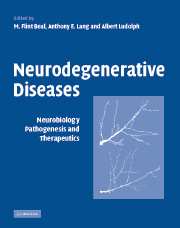Book contents
- Frontmatter
- Contents
- List of contributors
- Preface
- Part I Basic aspects of neurodegeneration
- Part II Neuroimaging in neurodegeneration
- Part III Therapeutic approaches in neurodegeneration
- Normal aging
- 25 Clinical aspects of normal aging
- 26 Neuropathology of normal aging in cerebral cortex
- Part IV Alzheimer's disease
- Part VI Other Dementias
- Part VII Parkinson's and related movement disorders
- Part VIII Cerebellar degenerations
- Part IX Motor neuron diseases
- Part X Other neurodegenerative diseases
- Index
- References
26 - Neuropathology of normal aging in cerebral cortex
from Normal aging
Published online by Cambridge University Press: 04 August 2010
- Frontmatter
- Contents
- List of contributors
- Preface
- Part I Basic aspects of neurodegeneration
- Part II Neuroimaging in neurodegeneration
- Part III Therapeutic approaches in neurodegeneration
- Normal aging
- 25 Clinical aspects of normal aging
- 26 Neuropathology of normal aging in cerebral cortex
- Part IV Alzheimer's disease
- Part VI Other Dementias
- Part VII Parkinson's and related movement disorders
- Part VIII Cerebellar degenerations
- Part IX Motor neuron diseases
- Part X Other neurodegenerative diseases
- Index
- References
Summary
Introduction
In order to understand the neuropathology of normal aging, it is instructive to review the major elements of circuit degeneration associated with Alzheimer's disease. AD is characterized by senile plaque (SP) and neurofibrillary tangle (NFT) formation and extensive, yet selective, neuron death in the hippocampus and neocortex that leads to dramatic decline in cognitive abilities and memory. A more modest disruption of memory, referred to as mild cognitive impairment (MCI) or age-associated memory impairment (AAMI), occurs often in the context of normal aging, in humans, monkeys and rodents. However, unlike AD, significant neuron death does not appear to be the cause of AAMI. In AD, the neurons providing the connection between the entorhinal cortex and the dentate gyrus (e.g. the perforant path) are devastated, as are the neurons providing corticocortical circuits that interconnect association regions. Whereas the death of these same neurons appears to be minimal in normal aging, these same circuits and the corresponding circuits in animal models are vulnerable to sublethal age-related alterations in morphology, neurochemical phenotype and synaptic integrity that might impair function. Biochemical alterations of the synapse, such as shifts in distribution or abundance of NMDA receptors, may also contribute to memory impairment. The same brain regions are also responsive to circulating estrogen levels, and thus, critical interactions between reproductive senescence and brain aging may affect excitatory synaptic transmission in the hippocampus. Importantly, some of the effects of estrogen on these neurons imply that certain synaptic alterations that accompany aging may be reversible.
- Type
- Chapter
- Information
- Neurodegenerative DiseasesNeurobiology, Pathogenesis and Therapeutics, pp. 396 - 406Publisher: Cambridge University PressPrint publication year: 2005

